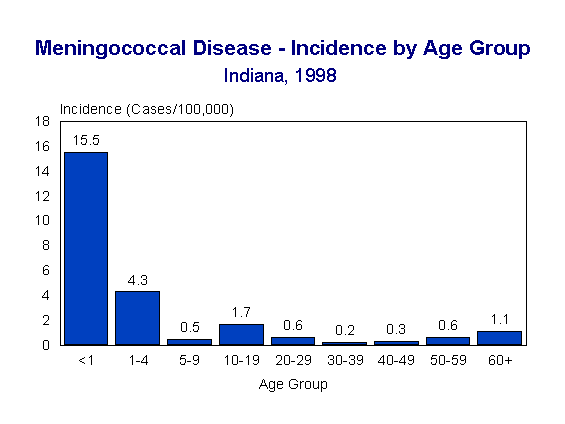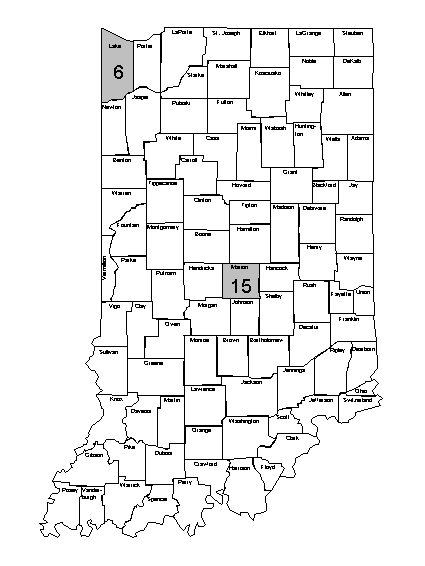
Meningococcal Disease
Cases = 70
Crude Rate (per 100,000 population) = 1.3
Age-adjusted race-specific rates (per 100,000
population)
White = 1.0
Nonwhite = 2.3
Sex-specific rates (per 100,000 population)
Females = 1.5
Males = 1.0
Meningococcal disease is usually transmitted person to person via respiratory droplets
from the nose and throat secretions of a person infected with Neisseria meningitidis.
A "probable" diagnosis is defined as a positive antigen test in the
cerebrospinal fluid (CSF) or clinical purpura fulminans in the absence of a positive
culture. A "confirmed" case is defined as a clinically compatible case that is
laboratory confirmed. All specimens must be obtained from a normally sterile site (e.g.
CSF, blood, synovial fluid, and pleural fluid or pericardial fluid). Among the general
population, the carriage rate of N. meningitidis in the nasopharynx is about 10 to
15%.
In 1998, there were 70 confirmed cases of meningococcal disease which represents a 21% increase over the previous 5-year mean (58 cases/yr) (Figure 1). The increased case reports may have been due to an increased awareness of the disease and it's reporting process among health care professionals. Educational information regarding meningococcal disease was distributed to doctors, hospital infection control personnel, clinical laboratory directors, and local health departments via the Indiana Epidemiology Newsletter and during 5 regional training sessions that occurred throughout the state during the spring of 1998.
Figure 1.

Nonwhites (2.3) were over 2 times more likely to develop invasive meningococcal disease than whites (1.0). The rate of disease among females was 50% greater than that for males (1.5 as compared to 1.0).
The incidence of meningococcal disease usually peaks in late winter to early spring. In 1998, there was a bimodal distribution with an increased number of cases occurring in later winter/early spring and, to a lesser extent, in the fall (Figure 2).
Figure 2.

Meningococcal disease tends to strike babies, children, and young adults. In 1998, incidence was highest for infants (15.5), followed by children under 5 (4.3) (Figure 3)
Figure 3.

There are several serogroups of N. meningitidis; and although there is a meningococcal vaccine available in the United States, it is not effective against all serogroups and is recommended only for certain groups of high-risk individuals including: people who have terminal complement component deficiency; people with anatomic or functional asplenia; travelers to or U.S. citizens residing in countries in which N. meningitidis is hyperendemic or epidemic; or personnel who are routinely exposed to N. meningitidis in solutions that my be aerosolized. Because of one study that documented a slightly higher incidence of invasive meningococcal disease in college students living on campus, these individuals may also consider obtaining the vaccine. The specific serogroups that the vaccine is effective against are A, C, Y, and W-135.
The ISDH requests that clinical laboratories submit all positive N. meningitidis isolates collected from a normally sterile site to the ISDH Disease Control Laboratory for free confirmation and serotyping. Table 2 describes the reported isolates for 1998.
Table 2.
Meningococcal Disease by Serotype, Indiana, 1996-1998
Serogroup |
1996 |
1997 |
1998 |
| A | 1 (1.6%) | -- | 1 (1.4%) |
| B | 14 (21.9%) | 18 (33.3%) | 20 (28.6%) |
| C | 8 (12.5%) | 11 (20.1%) | 14 (20.0%) |
| Y | 18 (28.1%) | 10 (18.5%) | 15 (21.4%) |
| W135 | 1 (1.6%) | -- |
1 (1.4%) |
| Z | 1 (1.6%) | 1 (1.9%) | -- |
| Ungroupable | 4 (6.3%) | 4 (7.4%) | 2 (2.7%) |
| Unknown | 17 (26.6%) | 10 (18.5%) | 16 (22.9%) |
| Total | 64 | 54 | 70 |
Only Lake (6 cases) and Marion (15 cases) Counties reported at least 5 cases in 1998
(Figure 4).
Figure 4. Meningococcal Disease by County
(among counties with > 5 reported cases)
Indiana, 1998

[an error occurred while processing this directive]